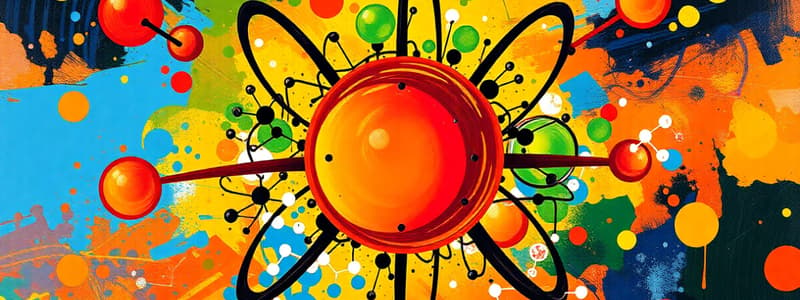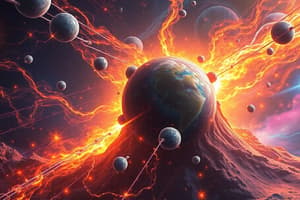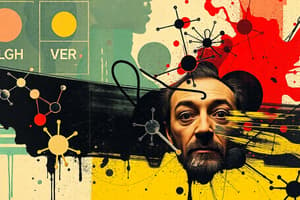Podcast
Questions and Answers
What is the basic unit that makes up all matter?
What is the basic unit that makes up all matter?
- Molecule
- Ion
- Compound
- Atom (correct)
Which of the following correctly differentiates between elements and compounds?
Which of the following correctly differentiates between elements and compounds?
- Elements are made of different types of atoms, while compounds are made of one type of atom.
- Elements are chemically combined substances, while compounds are pure substances.
- Elements cannot be broken down, while compounds can be broken down into simpler substances. (correct)
- Elements always exist in molecules, while compounds do not.
Which of the following correctly represents an element?
Which of the following correctly represents an element?
- O (correct)
- NaCl
- CO2
- H2O
What do chemical symbols represent?
What do chemical symbols represent?
In a word equation, which of the following is typically listed on the left side?
In a word equation, which of the following is typically listed on the left side?
What does a balanced symbol equation indicate?
What does a balanced symbol equation indicate?
When writing a half equation, what is maintained?
When writing a half equation, what is maintained?
Which of the following is an example of a balanced symbol equation?
Which of the following is an example of a balanced symbol equation?
What is a mixture?
What is a mixture?
Which separation technique is suitable for separating a solid from a liquid?
Which separation technique is suitable for separating a solid from a liquid?
How has the atomic model evolved due to experimental evidence?
How has the atomic model evolved due to experimental evidence?
What distinguishes the plum pudding model from the nuclear model of the atom?
What distinguishes the plum pudding model from the nuclear model of the atom?
What is the relative charge of a neutron?
What is the relative charge of a neutron?
Which is the correct relative mass of an electron compared to a proton?
Which is the correct relative mass of an electron compared to a proton?
If an atom has an atomic number of 6 and a mass number of 14, how many neutrons does it have?
If an atom has an atomic number of 6 and a mass number of 14, how many neutrons does it have?
What best describes isotopes?
What best describes isotopes?
What is the term for the weighted average mass of an element's isotopes, taking into account their relative abundance?
What is the term for the weighted average mass of an element's isotopes, taking into account their relative abundance?
How are electrons organized within an atom's energy levels?
How are electrons organized within an atom's energy levels?
What common characteristics do elements in the same group of the periodic table share?
What common characteristics do elements in the same group of the periodic table share?
Which early classification of elements primarily focused on grouping elements by their physical properties?
Which early classification of elements primarily focused on grouping elements by their physical properties?
What does the periodic table indicate about the reactivity of elements in the same group?
What does the periodic table indicate about the reactivity of elements in the same group?
For an element with isotopes of 75% $^{12}C$ (mass 12) and 25% $^{14}C$ (mass 14), what is its relative atomic mass?
For an element with isotopes of 75% $^{12}C$ (mass 12) and 25% $^{14}C$ (mass 14), what is its relative atomic mass?
How are elements arranged in the periodic table?
How are elements arranged in the periodic table?
Which of the following best describes why isotopes affect the calculation of relative atomic mass?
Which of the following best describes why isotopes affect the calculation of relative atomic mass?
What is one attribute of Mendeleev's periodic table that sets it apart from modern periodic tables?
What is one attribute of Mendeleev's periodic table that sets it apart from modern periodic tables?
Which property is characteristic of metals when compared to non-metals?
Which property is characteristic of metals when compared to non-metals?
What trend can be observed in the boiling points of noble gases as you move down the group?
What trend can be observed in the boiling points of noble gases as you move down the group?
What is the primary reason for the lack of reactivity of noble gases?
What is the primary reason for the lack of reactivity of noble gases?
Which of these properties increases as you move down the group of alkali metals?
Which of these properties increases as you move down the group of alkali metals?
How does the electron arrangement of halogens relate to their reactivity?
How does the electron arrangement of halogens relate to their reactivity?
What trend is observed in the molecular mass of halogens as you move down the group?
What trend is observed in the molecular mass of halogens as you move down the group?
What can be predicted about the reactivity of alkali metals as their atomic number increases?
What can be predicted about the reactivity of alkali metals as their atomic number increases?
Flashcards are hidden until you start studying
Study Notes
Atomic Structure
- Everything is made of atoms.
- Atoms are the smallest unit of an element that can exist.
- Elements are pure substances made up of only one type of atom.
- Compounds are formed when two or more elements combine in a fixed ratio.
- Elements and compounds are represented by symbols and formulae.
- Chemical reactions involve the rearrangement of atoms.
- Word equations describe reactions using the names of the reactants and products.
- Symbol equations use chemical symbols and formulae to represent the reactants and products
- State symbols are used to indicate the physical state of the reactants and products: (s) for solid, (l) for liquid, (g) for gas, (aq) for aqueous solution.
- Half equations show the change in oxidation state of an atom or a group of atoms.
- Ionic equations show the chemical reaction in terms of the ions involved.
- Mixtures are made up of two or more substances that are not chemically combined.
- Mixtures can be separated by physical processes such as filtration, distillation, evaporation, and chromatography.
Atomic Model
- Early models of the atom were based on limited experimental evidence.
- The plum pudding model proposed by J.J. Thomson, suggested a sphere of positive charge with negatively charged electrons embedded within it.
- In the nuclear model of the atom, the positively charged protons and neutral neutrons are located in the nucleus at the center of the atom.
- Rutherford's gold foil experiment showed that the atom has a dense, positively charged nucleus surrounded by a cloud of negatively charged electrons.
- Protons have a relative charge of +1 and a relative mass of 1.
- Neutrons have no charge (neutral) and a relative mass of 1.
- Electrons have a relative charge of -1 and a negligible mass (approximately 1/1836).
- The number of protons in an atom defines its atomic number.
- The mass number of an atom is the total number of protons and neutrons.
- Isotopes are atoms of the same element with the same atomic number but different mass numbers.
- The relative atomic mass (Ar) of an element takes into account the abundance of its isotopes.
- The relative atomic mass is a weighted average of the masses of the isotopes.
Electronic Structure
- Electrons occupy specific energy levels around the nucleus.
- Electrons fill energy levels, starting from the lowest energy level and moving to higher levels.
- The electron configuration of an atom can be represented using a diagram or a number.
Periodic Table
- The periodic table arranges elements by increasing atomic number.
- Elements with similar chemical properties are placed in the same group.
- Elements in the same period have the same number of electron shells.
- Mendeleev's periodic table was based on the elements' atomic weights and chemical properties.
- Mendeleev left gaps in his table for undiscovered elements and predicted their properties.
- Metals are typically shiny, malleable (can be hammered into thin sheets), ductile (can be drawn into wires) and good conductors of heat and electricity.
- Non-metals are typically dull, brittle, and poor conductors of heat and electricity.
- Noble gases (Group 0) are unreactive due to their full outer electron shells.
- Group 1 alkali metals are highly reactive due to their single outer electron.
- Group 7 halogens are reactive nonmetals with seven outer electrons.
- The reactivity of the halogens decreases down the group as the outer electron is further from the nucleus.
Studying That Suits You
Use AI to generate personalized quizzes and flashcards to suit your learning preferences.




